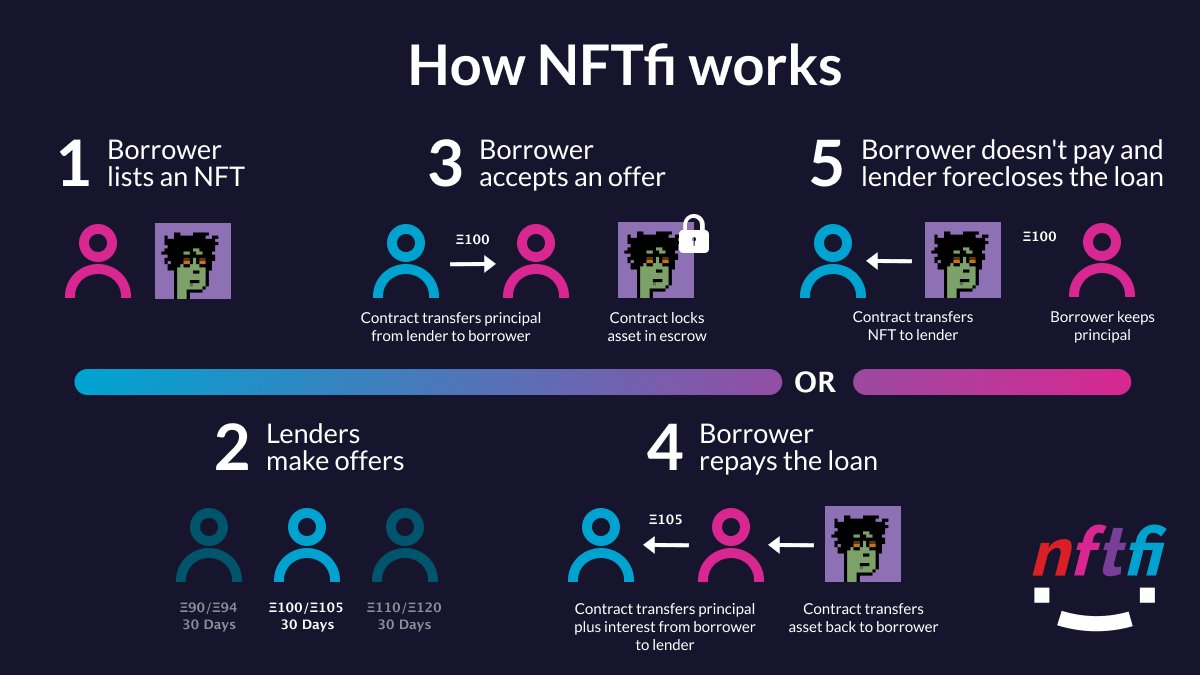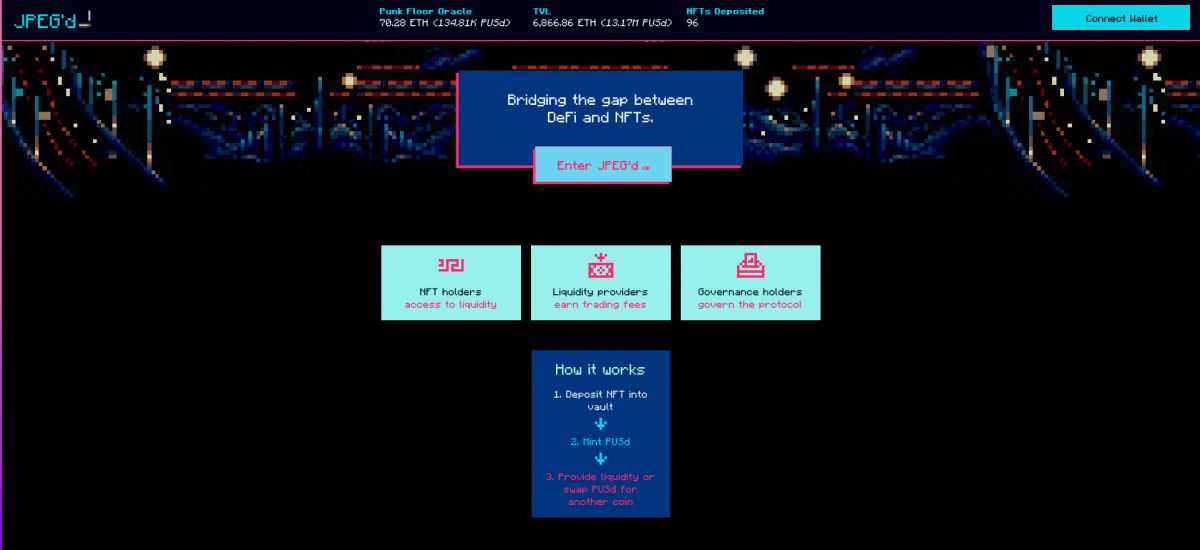Looking for liquidity? Here is everything to know about NFT loans

The past 24 months have been a whirlwind for NFT enthusiasts, with unprecedented demand for digital ownership creating a new and exciting asset class right before our eyes. But eventually all new toys lose their luster. And after a frenzied period of buying, selling and trading NFTs, investors are looking for new ways to leverage their holdings.
Enter the rise of fractional ownership, stakes and NFT’s hottest new sector: lending.
You read that right. People lend out their relatively illiquid JPEGs for instant payouts in crypto and cash. And it has become a massive part of the market.
It’s finally time to break down the basics of NFT lending – how it really works, and the different types of lending models.
But first a definition.
What is NFT lending?
NFT lending is the act of securing your NFT as a loan in exchange for immediate crypto payment. And that solves the asset class’s most important problem: Liquidity. Compared to other asset classes, NFTs are relatively illiquid – meaning that it is not easy to quickly sell the NFT for its stated market value in cash (or cryptocurrency). In other words, it could take months before someone buys your JPEG. Additionally, for investors with significant investment allocations tied up in NFTs, quick access to liquid capital can sometimes be difficult. Loans also provide NFT owners with a means of generating non-taxable income, as opposed to the tax implications of a sale.
This is how it works: The borrower needs a loan and provides an asset as security (NFT). The lender delivers the loan in exchange for interest. However, if the borrower cannot repay the loan on the agreed terms, the lender will receive the collateral. In most cases, this process is performed autonomously by smart contracts on the blockchain.
But in all cases, NFT lending is carried out via one of four main models, each with its own advantages and disadvantages.
Peer-to-Peer: NFT lending platforms made easy
The simplest form of NFT lending is peer-to-peer, as it closely resembles the relationship between a borrower and a lender that you might find at your local bank.
Most transactions take place on peer-to-peer NFT lending platforms such as NFTfi, and follow a similar process. But unlike borrowing against an asset with a stable price, NFTs are a bit trickier. The market is incredible volatile, meaning that the market value of an NFT today may be significantly different from its value. So how do you assess its current value?
The truth is that it depends. Most peer-to-peer lending platforms use a single offer system to allow anyone to provide loans and set terms without a centralized or third-party intermediary.
A user will list his NFT on the platform and receive a loan offer based on the lender’s perceived security value of the NFT. If the borrower accepts the offer, they will immediately receive a wrapper ETH or DAI from the lender’s wallet. At the same time, the platform will automatically transfer the borrower’s NFT to a digital escrow vault (read: smart contract) until the loan is either repaid or expires. If the borrower defaults on the loan, the smart contract automatically transfers the NFT to the lender’s wallet.

Consolidates multiple NFTs with Arcade and more
Other platforms such as Arcade allow users to consolidate or “wrap” multiple NFTs into a single security. Unlike NFTfi, Arcade allows borrowers to set their desired terms and repayment periods in advance, then search for a suitable lender match through the marketplace. Once a match is detected, the process begins.
The bottom line? Peer-to-peer lending has emerged as the most favorable option for both borrowers and lenders, mainly due to its ease of use and security. The flexibility for both parties to set terms helps account for rare NFT moves, and the smart contract logic in the escrow process is quite simple. However, it is important to note that peer-to-peer lending may not be fastest model, since it relies on a borrower finding a lender willing to agree to set terms mutually.
In accordance Richard ChenGeneral Partner in cryptocurrency-focused investment company 1confirmation, peer-to-peer lending is not only the safest model, but also the most liquid and competitive on the lending side.
“If you show a CryptoPunk on NFTfi, you’ll get a dozen offers pretty quickly,” Chen said in an interview with nft now. As DeFi interest rates have fallen, DeFi lenders have shifted to NFT lending, as that is where the highest yields in crypto are right now.”
Peer-to-Pool NFT lending
As the name suggests, peer-to-pool lending allows users to borrow directly from a pool of liquidity, rather than waiting to find a suitable lender match. To assign value to NFTs with certainty, peer-to-pool platforms such as BendDAO use blockchain bridges (Chainlink oracles, to be specific) to obtain floor price information from OpenSea and then allow users to instantly access a set percentage of NFT’s floor price as an NFT-backed loan. NFT is then simultaneously locked within the protocol.
When liquidation occurs, it is not based on the repayment time. Instead, it occurs when the health factor of the loan – which is a numerical representation of the collateral made up of the secured market value and the outstanding loan amount – falls below a certain threshold. However, the borrower has 48 hours to repay the loan and reclaim the security.
Meanwhile, lenders who added liquidity to the liquidity pool receive interest-bearing bendETH tokens, the price of which is linked one-to-one with the initial deposit.
Briefly summarized, with peer-to-pool lending you gain speed but lose flexibility. Since these platforms assign value based on floor prices, owners of rare NFTs are disadvantaged, limiting the amount of capital they have access to. The market for borrowing is also much smaller. While platforms like Pine offer access to multiple NFT collections, BendDAO is only compatible with select blue-chip NFTs. But most importantly, there is significantly greater platform and hacking risk compared to peer-to-peer, Chen said.
“Given the illiquidity of NFTs, the price oracles used in peer-to-pool can be manipulated much more easily compared to other tokens,” Chen said. For him, there are good NFT valuation tools like Deep NFT Value, but there is “no oracle infrastructure yet, so the teams are running their own centralized oracles which are exposed to the risk of infrastructure hacking.”
Non-fungible debt positions
A spin-off of MakerDAO’s collateralized debt position structure, where borrowers pledge ETH (a risky asset) in exchange for DAI (a less risky stablecoin), non-fungible debt positions offer a similar deal. However, on NFDP platforms like JPEG’d, instead of depositing ETH in exchange for a DAI, borrowers deposit select blue-chip NFTs and receive $PUSd, a synthetic stablecoin pegged to the USD, in return.
Similar to peer-to-pool lending, JPEG’d uses custom chainlink oracles to retrieve and maintain price data in the chain. The goal? To combine floor prices and sales data to price securities in real time with high accuracy.

Non-fungible debt positions remain very new, and must mature more before it is considered a recognized lending model. Targeted debt positions on MakerDAO are over-leveraged by 150 percent (or 1.5 times), to mitigate the volatility of ETH. NFTs are even more volatile and the lack of need for over-hedging raises some concerns about the unpredictability of the NFT market and future liquidations. In addition. JPEG’d is currently the only platform that offers this structure, and is limited exclusively to CryptoPunks, so the available market is small, and the platform risk is quite high. All things considered, non-fungible debt positions should command close scrutiny as they unfold.
NFT rental and leasing via capital
Breaking rank with the other three structures, NFT Leasing allows NFT holders to rent out their NFTs in exchange for upfront capital. Platforms like ReNFT work similarly to peer-to-peer marketplaces, enabling tenants and leaseholders to trade varying lease terms and agreements without waiting for permission.
Like exchanges on NFTfi, all rental transactions are facilitated by smart contracts. But instead of a borrower offering an NFT as collateral and locking it in a digital vault, the NFT is transferred to another person’s wallet for a specified period of time. In exchange, the “borrower” receives a lump sum of cryptocurrency. At the end of the predetermined period, the NFT is automatically returned to the owner. This is the simple form of “loan” as there are no repayment terms, interest or worry about liquidation.
Unlike other forms of lending where lenders are rewarded by earning interest, NFT leasing generally gives lenders access and credibility. The NFT space thrives on social proof, and owning an expensive NFT can increase attention and recognition in the space. Some communities are also token-gated, where renting an NFT helps users gain exposure to people and experiences they might not otherwise acquire. Like the rental of clothing, cars or other items of status-laden material, the emerging sector of NFT rentals is poised to be one of the most enduring.
Ultimately, whether NFT lending is the right decision for you specifically boils down to your time horizon and risk tolerance. Like all crypto protocols, it is important to do your own research and not over leverage or invest money you are not comfortable losing.

























